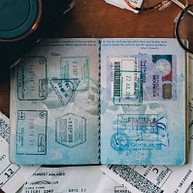
-
![poststamps]() Provided by: Ali Bakhtiari/unsplash
Provided by: Ali Bakhtiari/unsplash

Our travel guides are free to read and explore online. If you want to get your own copy, the full travel guide for this destination is available to you offline* to bring along anywhere or print for your trip.
*this will be downloaded as a PDF.Price
€4,95
Post
The guide was updated:Correo Argentino is the government postal service. Correo International (Retiro bus station) should be used for the delivery of international packages weighing over 2kg. The government run postal service is not known for its speed or reliability. Consider using private companies for sending valuable paperwork.
Private services in town are: DHL, Fedex, OCA, Andreani.
Useful Information
- Address: Correo Argentino: Sucursal Plaza Rodriguez Peña, Uruguay 1069, Buenos Aires
- Opening hours: Mon–Fri 10am–6pm, Sat & Sun closed
- Phone: +54 11 4816 7543
Digital Travel Guide Download
Our travel guides are free to read and explore online. If you want to get your own copy, the full travel guide for this destination is available to you offline* to bring along anywhere or print for your trip.
*this will be downloaded as a PDF.Price
€4,95

Ministro Pistarini International Airport (EZE), more commonly referred to as simply Ezeiza International Airport, is located about 22 kilometres outside of Buenos Aires. It is the largest airport in Argentina, handling about 85% of the country's international air traffic, and is the hub for Aerolíneas Argentinas and LAN Argentina.
The easiest way to get to the city from the airport is by taking one of the authorised taxis from the stalls just outside the terminals. The ride should take about 30 minutes.
There are also minibus and shuttle services that are cheaper, but only have services to each company's terminal, so travellers must switch to local transportation for the rest of the journey.
Some public buses run to central areas of the city. Bus 51 goes to Constitución and number 86 goes to Plaza de Mayo.
Read more

Passport & Visa
Argentina can be visited visa-free for up to 90 days by citizens of most European countries, Australia, New Zealand, Japan, South Korea, Israel, UAE and most countries in America.
Visitors coming from Jamaica, Kazakhstan and Malaysia can enter the country without a VISA for a stay of up to 30 days. Whereas those coming from Kosovo, Nauru, Taiwan, Tonga and Tuvalu must use a Travel Certificate issued by Argentina instead of a VISA.
If you are unsure whether or not you need to apply for a visa, we recommend contacting the embassy or consulate in your country.
Read more

Best Time to Visit
The best time to visit Buenos Aires is in the fall, from April to June or in the spring, from September to December. At these times of the year the city is usually less crowded, the weather milder and hotel prices lower.
It is not recommended to visit Buenos Aires during the peak season (South American summer) from January to February, given that it is characterised by high temperatures and a higher inflow of tourists.
On the other end, winter isn't usually magnanimous with visitors, who normally experience cold and rainy days lasting from June to August.
Some interesting events throughout the year are:
February: Carnaval Porteño
March: Opening of Opera and Ballet season
April: International Horse Riding Exhibition; Buenos Aires Book Fair
May: May Revolution Day (25th); International Decorative Art Fair
July 9: Independence Day
August: Fashion Week; Tango Festival and World Championship
November: Gay Pride; International Buenos Aires Jazz Festival; Creamfields
Read more

Buenos Aires Cruise Port
The Cruise Terminal in Buenos Aires, called Terminal de Cruceros Benito Quinquela Martín. The Buenos Aires port is located about 2 km from the downtown. It might look close on the map, but the area is quite deserted — you will be better off taking a shuttle buses or a taxi. Taxis are always available at the terminal.
The Buenos Aires port has a yacht berth called Puerto Madero, which is a modern re-developed area popular with locals.
Read more

Public Transport
Public Transport in Buenos Aires is efficient and affordable and by far the best way to get around. There are two types of buses (regular 'colectivos' and Metrobus), as well as Latin America's oldest subway system, or 'Subte'. All public transport in the city is paid using the rechargeable SUBE card, which can be purchased at post offices and corner shops.
Bus stops are ubiquitous. Be sure to stand in line at the bus stop, as they are strictly respected. Tell the driver where you're going and he'll let you know how much the fare is, as it varies depending on how far you are traveling. Colectivos run 24 hours, though less frequently at night. Metrobuses have dedicated lanes along major roads to speed across the city, and many stations have free WiFi.
The Subte is clean, reliable and both the fastest and cheapest way to get around. Trains run often, every 3-10 minutes, Mon-Fri 5am–10:30pm, Sun 8am–10pm. Several lines run parallel East to West, while line C crosses them going North to South.
Read more

Taxis
Buenos Aires' black and yellow taxis are ubiquitous and can be flagged down anywhere. Rides are metered, and fares go up 20% at night. You can order a taxi through the official BA Taxi mobile application.
Onda Verde: +54 11 4867 0000
Premium: +54 11 4374 6666, +54 11 5238 0000
Didi and Uber rideshare apps are available in Buenos Aires.
Read more

Post
Correo Argentino is the government postal service. Correo International (Retiro bus station) should be used for the delivery of international packages weighing over 2kg. The government run postal service is not known for its speed or reliability. Consider using private companies for sending valuable paperwork.
Private services in town are: DHL, Fedex, OCA, Andreani.
Read more

Pharmacy
Argentina has an outstanding pharmaceutical industry. If you have a regular prescription, be sure to have your doctor write down the name of the drug, not just the brand name.
You can easily spot pharmacies by their green-and-white crosses. The largest and most common pharmacy chain is called Farmacity. Their stores will often be open around the clock.
Read more

Telephone
Country code: +54
Area code: 11
Read more

Electricity
In Argentina the power plugs and sockets are of type C (also known as the standard "Euro" plug) and I. Type I is mainly used in Australia, New Zealand, China and the South Pacific, and comes with two flat prongs at an angle and an optional ground pin.
The standard voltage is 220–240 V and the frequency is 50 Hz.
Read more


